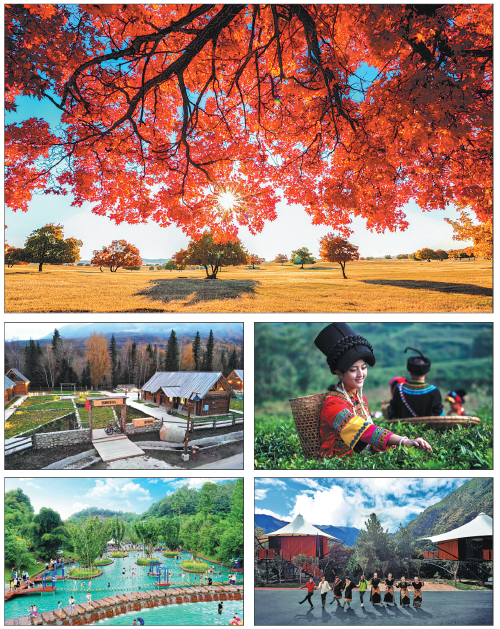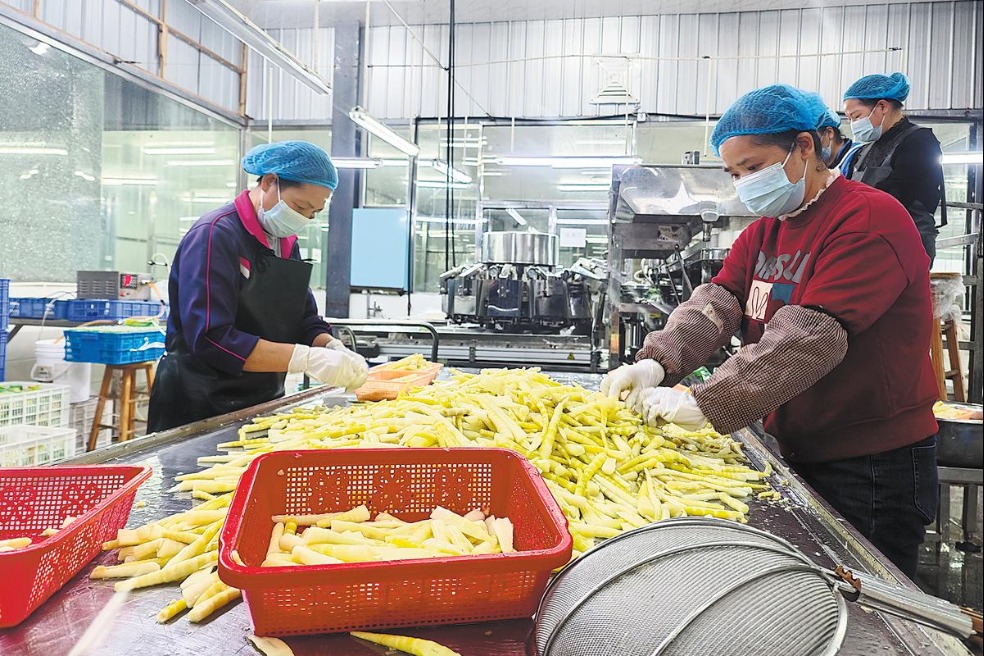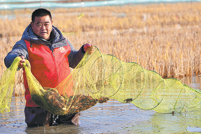A natural evolution
Major tourism players turn their attention to building resorts that capture the essence of rural life, Yang Feiyue reports.

Culture and tourism players are making moves to tap into the potential offered by the charm of the vast countryside, bringing big changes to life in those areas.
The country's major online travel agency Trip.com Group opened two retreats in Northwest China's Xinjiang Uygur autonomous region in late October.
The idea is to help local villagers to increase income through tourism and allow travelers to better savor what Xinjiang has to offer in its rural areas.
One of them sits in Hemu village, Burqin county in Altay. Travelers can commune with nature at the facility through the vast grasslands that are surrounded by mountain ranges, and are imbued with a strong nomadic culture.
The facility features five courtyards and 11 homestays and includes a garden area of more than 10,000 square meters.
It helped locals to renovate their houses for tourism purposes, get tour-service jobs and sell their farm produce.
To date, half of the resort's employees are local villagers.
The buildings and decorations go beyond local requirements for environmental protection, says Chen Kong, who is in charge of the operation of the facility.
The stone used in the construction is locally sourced and wooden materials are certified by the Forest Stewardship Council, an international nonprofit organization that promotes responsible management of the world's forests.
"During our team building events, we'll arrange for employees to go out and clean up the garbage discarded by tourists" Chen says.
"Employees will also guide guests in establishing green consumption habits."
About a five-hour drive away, the other retreat beside the Kanas Lake in Burqin county offers nine guest rooms with stunning mountain and lake views.
"We have undertaken cultural innovation research and development based on Xinjiang's folk culture, so that customers can better immerse themselves in Xinjiang's culture and understand it during their stay," says Yan Rui, manager of the resort.
The Xinjiang facilities are part of Trip.com Group's rural tourism revitalization strategy that was announced earlier this year.
The online agency plans to set up a 1 billion yuan ($156.3 million) fund to build model destinations in the country's rural areas. In particular, 10 high-end rural retreats are at the heart of the strategy.
A total of 100 tourism villages and 10,000 rural tourism staff will be developed in the next five years, according to Trip.com Group.
"As an important means to boost rural revitalization, the development of rural tourism has created new opportunities for the industry," says Liang Jianzhang, co-founder of Trip.com Group.
To date, the agency has developed five retreats in Anhui, Henan and Hunan provinces.
The first one, at Dawan village, Anhui province, began operations on July 3 and the rural resorts proved popular among travelers during the recent National Day holiday.
Some reported occupancy rates of more than 90 percent 15 days ahead of the holiday, according to the agency.
China's rural areas have long since broken through many of the bottlenecks in transportation and infrastructure construction, but there remains obvious room for improvement in the high-end accommodation sector, Liang says, adding that the rural homestay project is a bid to solve at least part of that problem, encouraging visitors to stay over during their visits to rural areas.
The online agency has also set up learning programs to offer travel-service training and operational skills to local villagers, which is an important measure in realizing high-quality culture and tourism development in rural areas, according to Wu Shan, an official with the online agency's culture and tourism research center.
In 2019, the rural tourism sector saw 3.3 billion travel visits, with operating revenue exceeding 850 billion yuan, according to the Ministry of Agriculture and Rural Affairs.
It has also shown a strong recovery since the pandemic emerged.
In the first six months of this year, the number of tourists to Beijing's rural areas has recovered to 66.1 percent of that of the same period in 2019, and business revenue has recovered to some 90 percent, according to the local authority.
At a national promotion meeting for high-quality rural industry development by the ministry in March, the country will strive to achieve more than 4 billion travel visits to rural villages by 2025, with operating revenue breaking 1.2 trillion yuan. It is expected to benefit over 15 million people.
Such promise has seen other tour players make inroads in rural tourism development.
The culture and tourism conglomerate Overseas Chinese Town Group shared its experiences in rural revitalization at the Anren Forum, which was held in Chengdu, Sichuan, on Oct 16 and 17.
The forum brought together more than 30 State-owned enterprises, alongside dozens of experts, and aimed to explore sustainable approaches for rural revitalization.
Since last year, OCT Group has deepened strategic cooperation with rural areas in Guizhou, Sichuan and Gansu provinces to improve local folk customs and the local environment, as well as tap into local culture and tourism resources.
State-owned enterprises have to take a lead in boosting rural vitalization and modernization of agriculture and rural areas, says Ren Hongbin, vice-chairman of the State-owned Assets Supervision and Administration Commission of the State Council.
The OCT Group has developed about 30 distinctive rural projects across the country, including the Beijing-Tianjin-Hebei region, the Yangtze River Delta, Hainan and Yunnan.
Those scenic spots have received 40 million tourist visits annually on average, bringing 160,000 people out of poverty, according to OCT.
Since 2016, at Zhongliao village in Hainan province, local ethnic Li elements have been retained as part of the construction of a pastoral getaway and art performance venue by the group.
"Our living environment has improved, and tourism has been all the rage in the village," says Su Yingnuan, a local in Zhongliao.
"We can enjoy employment on our doorsteps and an increase in income, so we all feel happy," Su says.
At Xiaopuxi village, Xishuangbanna Dai autonomous prefecture, Yunnan, a health preservation facility featuring tea tours has drawn travelers from far and wide.
The village is home to the Jino ethnic group.
The development by OCT Group has given the previously poor village a facelift, says Bai Chunguo, a village official.
"The tea trees on the mountain and the Jino culture have brought us development opportunities. Villagers can receive friends from all over the world without leaving the village." Bai says.

Today's Top News
- China to apply lower import tariff rates to unleash market potential
- China proves to be active and reliable mediator
- Three-party talks help to restore peace
- Huangyan coral reefs healthy, says report
- PLA conducts major drill near Taiwan
- Washington should realize its interference in Taiwan question is a recipe it won't want to eat: China Daily editorial






























